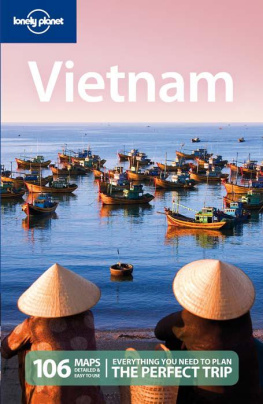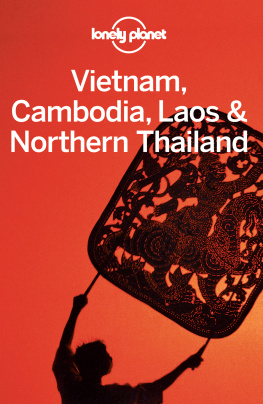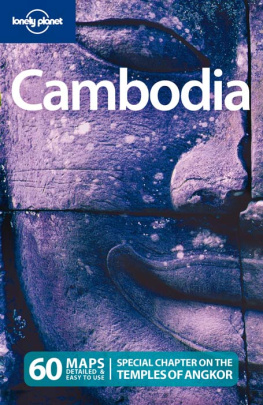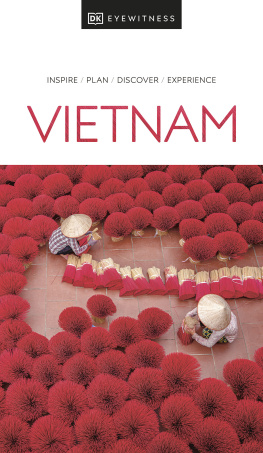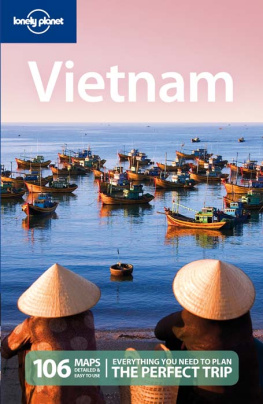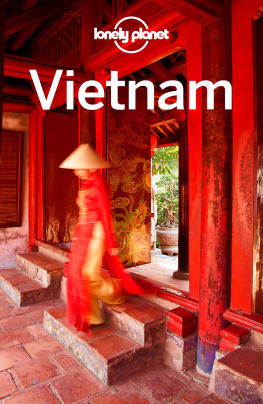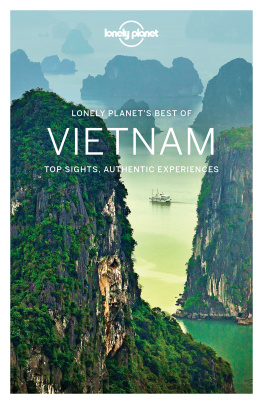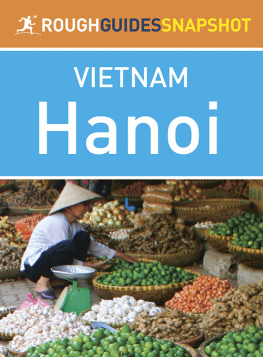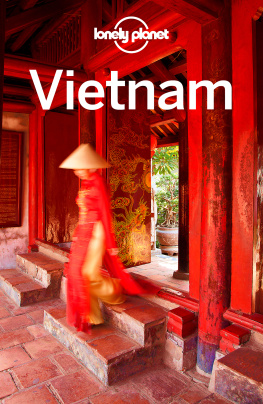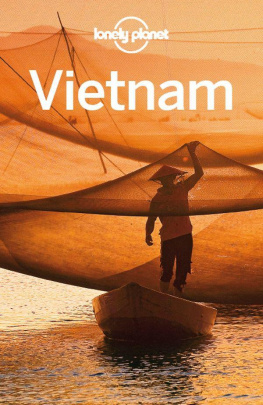On the Road
NICK RAY Coordinating Author
Most folk dont realise that the Ho Chi Minh Highway (Hwy 1A) connects Hanoi and Ho Chi Minh City via the Truong Son Mountains and is breathtakingly beautiful. I crossed the border from Laos into Vietnam at Bo Y and headed north. The scenery is sublime with jagged peaks, raging rivers and little oases of green where rice is grown. The scenery around Phong Nha is Halong Bay on land, and continues almost all the way to the suburbs of Hanoi.
YU-MEI BALASINGAMCHOW My first day on the job and my motorbike driver gleefully deposited me at the foot of a small hill outside Ninh Binh. Up, up nice to see! he exhorted. Five hundred steep stone steps later, I had an incredible view of rice fields and limestone landscapes. Well worth the climb, but I wish someone had warned me to bring some water.
IAIN STEWART Punting a bamboo raft on the Quay Son river that forms the border between Vietnam and China, with the Ban Gioc waterfall in the background. Ho Chi Minh re-entered Vietnam in this remote region (after decades in exile) and plotted the overthrow of the French from a cave close by.
Contents
Destination Vietnam
If there is one country in Southeast Asia that everyone has heard about long before they discover the region, its Vietnam. Of course, such infamy wasnt always for the right reasons, but this is the new Vietnam and its one of the most intoxicating places on earth. Its a kaleidoscope of vivid colours and subtle shades, of exotic sights and curious sounds, of compelling history and contrasting cultures.
Nature has blessed Vietnam with a bountiful harvest. From the soaring mountains of the far north to the carpet of emerald-green rice paddies in the south, Vietnam is little short of stunning. The curvaceous coastline is defined by endless beaches, lovely lagoons and hidden coves. Inland, peasant women in conical hats still tend to their fields, children ride buffalo along country paths, and minority people scratch out a living from impossible gradients.
If Vietnam has a soundtrack, its the buzz of a million motorbikes, the cries of street hawkers plying their wares and the tinkle of pagodas drawing the faithful to prayer. Here, the modern and medieval collide. The big cities are strikingly sophisticated, with gourmet restaurants and designer boutiques, but turn a random corner and find yourself travelling back in time. Embrace the street life with a bowl of pho at a pint-sized plastic table.
FAST FACTS
Population: 86 million
Life expectancy: 68 for men, 74 for women
Infant mortality: 24 per 1000 births
GDP: US$70.2 billion
Adult literacy rate: 94%
Annual rice production: 34.4 million tonnes
Tonnage of bombs dropped on Vietnam during the American War: 15 million
Number of motorbikes: 16 million and counting
Litres of nuoc mam (fish sauce) produced per year: 200 million plus
Members of Communist Party: 2 million
For culinary crusaders, Vietnam is a treasure trove of more than 500 different dishes. Its a wonderful world of pungent herbs and secret spices. Dip delicate spring rolls in nuoc mam, a fish sauce that, for the Vietnamese, is as compulsory as ketchup. Or play down-in-one with ruou (pronounced xeo), the whisky of the mountains.
Nam to a generation, the sorrow of war weighs heavily on the consciousness of all who can remember it, and the Vietnamese side of the story is told at poignant sites across the country. Although fiercely protective of their independence and sovereignty, the Vietnamese are graciously welcoming of foreigners who come as guests not would-be conquerors. Of course, the countrys history did not begin and end with the American War and the country is littered with vestiges of empires past and battles fought, all of which are elements in piecing together the story of Vietnam today.
Politically, Vietnam remains a perplexing place. Apparently, its a communist country, but capitalism is no longer a four-letter word. The cities are awash with money, but not everyone is getting a share. Transparency International rated Vietnam 121st out of 179 countries surveyed for its corruption index, on a par with Nigeria. Some observers argue this is why Vietnam needs to embrace democracy, to hold the politicians accountable for their actions; others argue that a firm hand drives the country forward economically, creating a stable environment for investors. Either way, there is no doubt the latest Asian dragon has awoken from its slumber.
Tourism has had a huge impact on Vietnam in the past two decades, helping plug the Vietnamese back into the world. It has spread into areas that other businesses cannot reach, and empowered a new generation of young Viets to a better life. The Vietnamese people are dynamic in commerce and dedicated to their families. They love to share a joke, a story, and getting to know some Vietnamese beyond the tourism industry can be the highlight of a visit. The Vietnamese have a vitality as tangible as the traffic on the street.
Vietnam is in top gear. Try and catch it before it reinvents itself as another Malaysia or Thailand. For now, it remains one of the most enriching, enlivening and enticing countries on earth.
Getting Started
Vietnam is the flavour of the month these days and its not just down to the delectable cuisine. The country offers an intoxicating blend: vibrant yet traditional cities, unashamedly idyllic coastline, incredible scenery, pulsating history and culture, and a kaleidoscope of people. Vietnam has it all, but its also raw in places, so pack some flexibility, humour and patience. Come expecting the unexpected, be ready for an adventure as much as a holiday, and Vietnam will deliver.
WHEN TO GO
When it comes to weather, its a tough call, as Vietnams climate is so diverse. Think frosts and occasional snow in the mountains of the north, and temperatures soaring to 40C in the south during the dry season.
Vietnams weather is dictated by two monsoons, meaning double trouble on the rain front. The winter monsoon comes from the northeast between October and March, bringing damp and chilly winters to all areas north of Nha Trang, and dry and warm temperatures to the south. From April or May to October, the summer monsoon brings hot, humid weather to the whole country except for those areas sheltered by mountains. For the best balance, wed vote for the months of April, May or October. For those sticking to the south, November to February is dry and a touch cooler. From July to November, violent and unpredictable typhoons hit central and northern Vietnam, which can dampen the spirits of even the most enthusiastic traveller.
See Climate Charts () for more information.
It gets pretty crowded from November to March and in July and August during high season. Domestic tourists are a major force now and they tend to travel in numbers during July and August as well. Prices peak over the Christmas and New Year period, and if you dont fancy sharing the sites with the masses, try to avoid this busy time. May, June and September are usually the quietest months.
Some travellers like to time a visit with Tet (Vietnamese New Year; ), the biggest festival in the calendar, which falls in late January or early February. Its a nice idea in principle, but not in practice, as the whole country is on the move and prices rise dramatically. Transport is crammed in the run-up and aftermath, the Reunification Express shuts down during festivities, and most shops and businesses are closed for the best part of a week.

